| Contents
Home
General
Info
Ordering
Info
Contact us
Cartridge
Lists
Patent & Miscellaneous
Rim Fire
Center Fire Pistol
Center Fire Rifle
Metric Rimfire,
Pistol&Rifle
British Pistol and Rifle
Shotgun Shells
Posters
This Month's Picture Page
Picture Page Index (NEW)
Prior Picture Pages:
*
September 2003
*
October 2003
*
November 2003
*
December 2003
*
January 2004
*
February 2004
*
March 2004
*
April 2004
*
May 2004
*
June 2004
*
July 2004
*
August 2004
*
September 2004
*
October 2004
*
November 2004
*
December
2004
*
January 2005
*
February
2005
*
March
2005
*
April
2005
*
May 2005
* June 2005
* July 2005
*
August 2005
*
September
2005
*
October 2005
Links to Other Sites
Cartridge Collectors Organizations:
IAA
ECRA
SAAACA
Auctions:
Auction
Arms
E-Bay
Ward's Collectibles
Sold USA
Books:
Armory
Publications
WCF Publications
Other Collector's Sites:
Curtis Steinhauer
|
Home of the Old Ammo Guy's Virtual
Cartridge Trading Table
Featuring a wide range of antique,
obsolete, and modern ammunition for collectors
Picture Page
November
2005
Thoughts on a Philadelphia Centennial
Exposition 45-70 draw set......
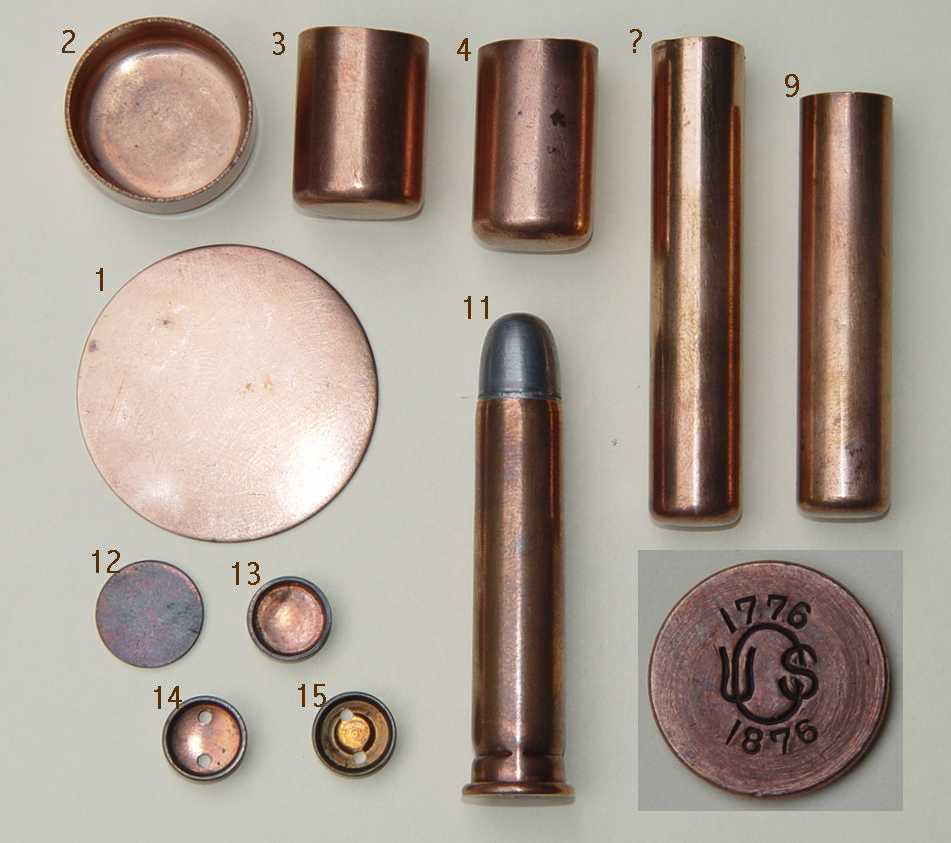 Here's
an interesting item that will be of interest to the cartridge collector, as
well as the Springfield Trapdoor enthusiast, US history buffs in general,
and those who are looking for the $2 garage sale find that will virtually
guarantee you an appearance on the Antiques Road Show. In 1876, the US Centennial Exposition was
held in Philadelphia. One of the many exhibits at the exposition consisted
of a working display of cartridge-making machinery from the Frankford
Arsenal, which was used to demonstrate the processes involved in manufacturing ammunition. The
cartridge cases that were produced were given away as souvenirs to the visitors
at the exposition, but, surprisingly, few seem to have survived. These
souvenirs consisted of special inert Benet-primed copper .45-70 ball (2.1")
and blank (1.6") cartridge cases with a unique 1776 USC 1876
headstamp, as well as multi-piece draw sets, similar to the one pictured,
showing the various stages in the production of the cartridge case. As
originally produced, it has been suggested that these draw sets consisted of
16 pieces, as shown in this illustration taken from Robert Buttweiler's Here's
an interesting item that will be of interest to the cartridge collector, as
well as the Springfield Trapdoor enthusiast, US history buffs in general,
and those who are looking for the $2 garage sale find that will virtually
guarantee you an appearance on the Antiques Road Show. In 1876, the US Centennial Exposition was
held in Philadelphia. One of the many exhibits at the exposition consisted
of a working display of cartridge-making machinery from the Frankford
Arsenal, which was used to demonstrate the processes involved in manufacturing ammunition. The
cartridge cases that were produced were given away as souvenirs to the visitors
at the exposition, but, surprisingly, few seem to have survived. These
souvenirs consisted of special inert Benet-primed copper .45-70 ball (2.1")
and blank (1.6") cartridge cases with a unique 1776 USC 1876
headstamp, as well as multi-piece draw sets, similar to the one pictured,
showing the various stages in the production of the cartridge case. As
originally produced, it has been suggested that these draw sets consisted of
16 pieces, as shown in this illustration taken from Robert Buttweiler's
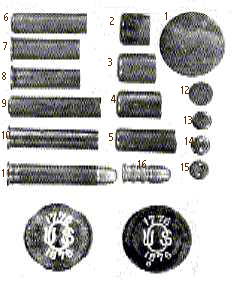 Collector's Ammunition
auction catalog, Vol. X, Number 1, lot 86 (1994), to which I have added
numbers to the various pieces. The description from the auction catalog for
Lot #86, while difficult to read, is also shown below, and describes this an
the only known complete set among the five other known sets. Items 1 through
5 show the transformation from a flat copper disk (item 1) through 4 early
stages (or draws) in the production of the case. The set also has three
pieces intended for making blank cartridges (items 6, 7 and 8) and three for
making ball cartridges (items 9, 10 and 11). Of these, the pieces which have
been through the rimming process (items 7, 8, 10, and 11) have the special
exposition headstamp. Items 12 through 15 show the stages in making the
Benet cup, which fits inside the finished case, and is held in place by low
grooves on either side of the case. Item 16 is a 405 grain grooved lead
bullet, which was used for both rifle and carbine cartridges at the time;
the 500 grain bullet did not become the standard for rifles until January of
1882. That the set in the top picture has only 11 items would lead one to
conclude that it is missing five of its original pieces. I numbered the
pieces in top picture to correspond with the matching pieces in the auction
picture. Obvious from a comparison between the pictures is that the top set
appears to be missing items 5, 6, 7, 8, 10, and 16; six pieces rather than
the five that would be expected (16-11=5). The discrepancy is caused by the extra-long
(2.610") piece with the uneven mouth labeled '?' in the top picture
(the second item in from the top right) that is
not in the auction picture. The presence of this 'non-standard' piece leads
me to believe that either the auction set is incomplete and should have had
17 or more pieces, or, more likely, that these draw sets were not so
consistent as to be able to make a blanket statement regarding what
comprises the 'complete' set. Any
comments or reactions to my thoughts here would be appreciated. Collector's Ammunition
auction catalog, Vol. X, Number 1, lot 86 (1994), to which I have added
numbers to the various pieces. The description from the auction catalog for
Lot #86, while difficult to read, is also shown below, and describes this an
the only known complete set among the five other known sets. Items 1 through
5 show the transformation from a flat copper disk (item 1) through 4 early
stages (or draws) in the production of the case. The set also has three
pieces intended for making blank cartridges (items 6, 7 and 8) and three for
making ball cartridges (items 9, 10 and 11). Of these, the pieces which have
been through the rimming process (items 7, 8, 10, and 11) have the special
exposition headstamp. Items 12 through 15 show the stages in making the
Benet cup, which fits inside the finished case, and is held in place by low
grooves on either side of the case. Item 16 is a 405 grain grooved lead
bullet, which was used for both rifle and carbine cartridges at the time;
the 500 grain bullet did not become the standard for rifles until January of
1882. That the set in the top picture has only 11 items would lead one to
conclude that it is missing five of its original pieces. I numbered the
pieces in top picture to correspond with the matching pieces in the auction
picture. Obvious from a comparison between the pictures is that the top set
appears to be missing items 5, 6, 7, 8, 10, and 16; six pieces rather than
the five that would be expected (16-11=5). The discrepancy is caused by the extra-long
(2.610") piece with the uneven mouth labeled '?' in the top picture
(the second item in from the top right) that is
not in the auction picture. The presence of this 'non-standard' piece leads
me to believe that either the auction set is incomplete and should have had
17 or more pieces, or, more likely, that these draw sets were not so
consistent as to be able to make a blanket statement regarding what
comprises the 'complete' set. Any
comments or reactions to my thoughts here would be appreciated.
.
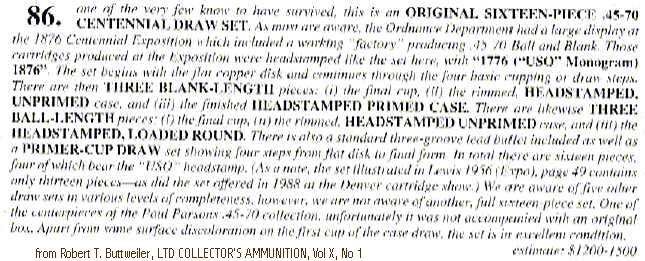
.
.
.
An interesting thick-rim
cartridge.......
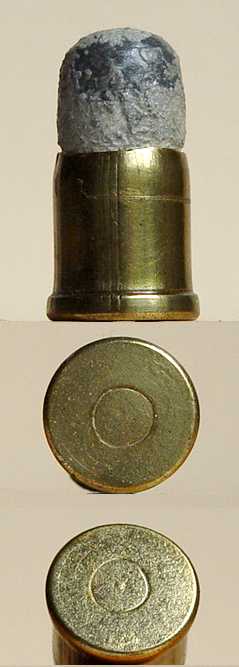 Looking
like just one more of the many variations of the French thick-rim cartridge,
this is actually a 11mm Bachmann-primed example, recognizable by its
characteristic irregular-edged flat 'disc' primer and its blunt nose lead
man-stopper-style bullet. The thick-rim family of cartridges was intended for use in Lefeauchaux
and other pin-fire revolvers that had been converted to centerfire. In the process of the conversion, the straight
chambers of the cylinders of these revolvers were cut to accept the rims of the centerfire
cartridges; the purpose of the extra-thick rim was to completely cover and
seal the holes around the perimeter of the cylinder intended for the
pins of the original pinfire cartridges to pass through.. Looking
like just one more of the many variations of the French thick-rim cartridge,
this is actually a 11mm Bachmann-primed example, recognizable by its
characteristic irregular-edged flat 'disc' primer and its blunt nose lead
man-stopper-style bullet. The thick-rim family of cartridges was intended for use in Lefeauchaux
and other pin-fire revolvers that had been converted to centerfire. In the process of the conversion, the straight
chambers of the cylinders of these revolvers were cut to accept the rims of the centerfire
cartridges; the purpose of the extra-thick rim was to completely cover and
seal the holes around the perimeter of the cylinder intended for the
pins of the original pinfire cartridges to pass through..
.
.
.
.
.
.
.
.
An unusual Frankford Arsenal reloading
accessory....
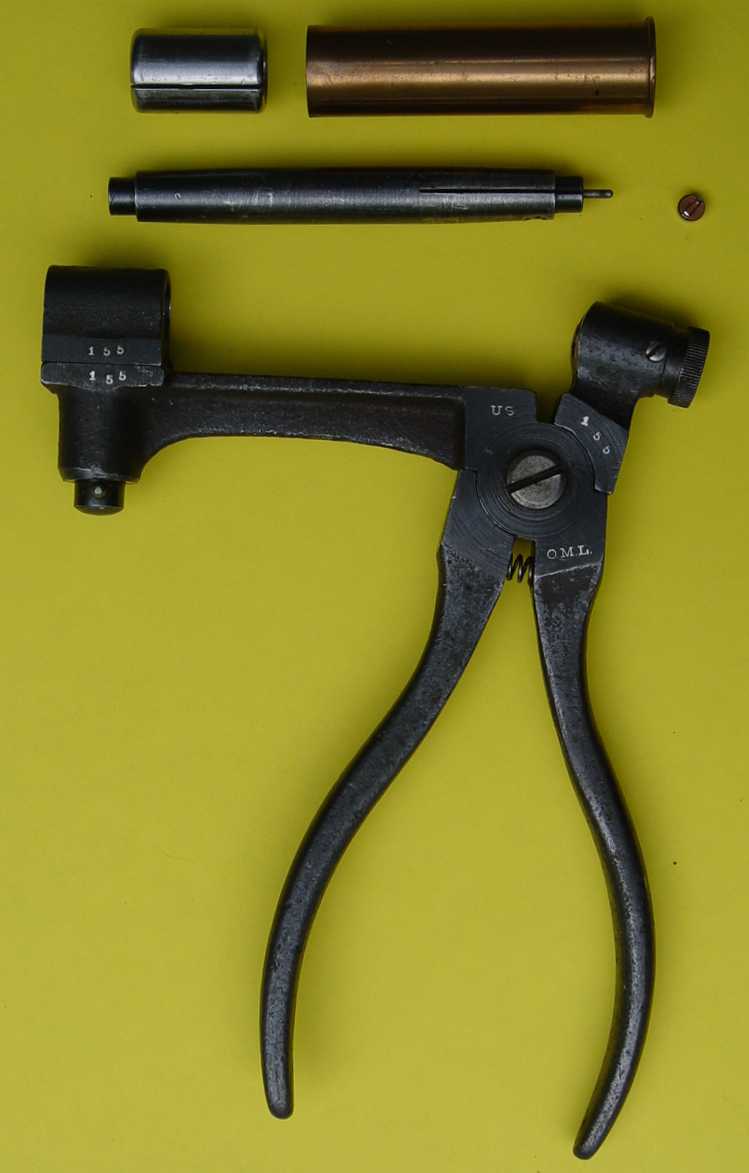 The
Gill priming tool that is included in the set of Frankford Arsenal reloading
tools shown on my picture page last month, in addition to being used for
de-priming and re-priming the .45 Colt, .45-55, 45-70, and .45-80
cartridges, was also used with the 20 gauge shell that was produced for the Springfield Model 1881 shotgun. Converting the tool for this purpose
requires a sleeve (the silver, slotted piece in the top left of this
picture) to be slipped onto the spindle to hold the shell in place. This
priming tool is marked 'U.S.' and 'O.M.L.', the initials of ordnance
inspector Major Ormond Mitchell Lissak; in addition, the three major parts
of tool are marked with assembly number 155. The sleeve has no markings, and
could easily be overlooked as a Frankford Arsenal accoutrement. The
following pictures demonstrate the priming process. The
Gill priming tool that is included in the set of Frankford Arsenal reloading
tools shown on my picture page last month, in addition to being used for
de-priming and re-priming the .45 Colt, .45-55, 45-70, and .45-80
cartridges, was also used with the 20 gauge shell that was produced for the Springfield Model 1881 shotgun. Converting the tool for this purpose
requires a sleeve (the silver, slotted piece in the top left of this
picture) to be slipped onto the spindle to hold the shell in place. This
priming tool is marked 'U.S.' and 'O.M.L.', the initials of ordnance
inspector Major Ormond Mitchell Lissak; in addition, the three major parts
of tool are marked with assembly number 155. The sleeve has no markings, and
could easily be overlooked as a Frankford Arsenal accoutrement. The
following pictures demonstrate the priming process.
.
.
.
.
.
.
.
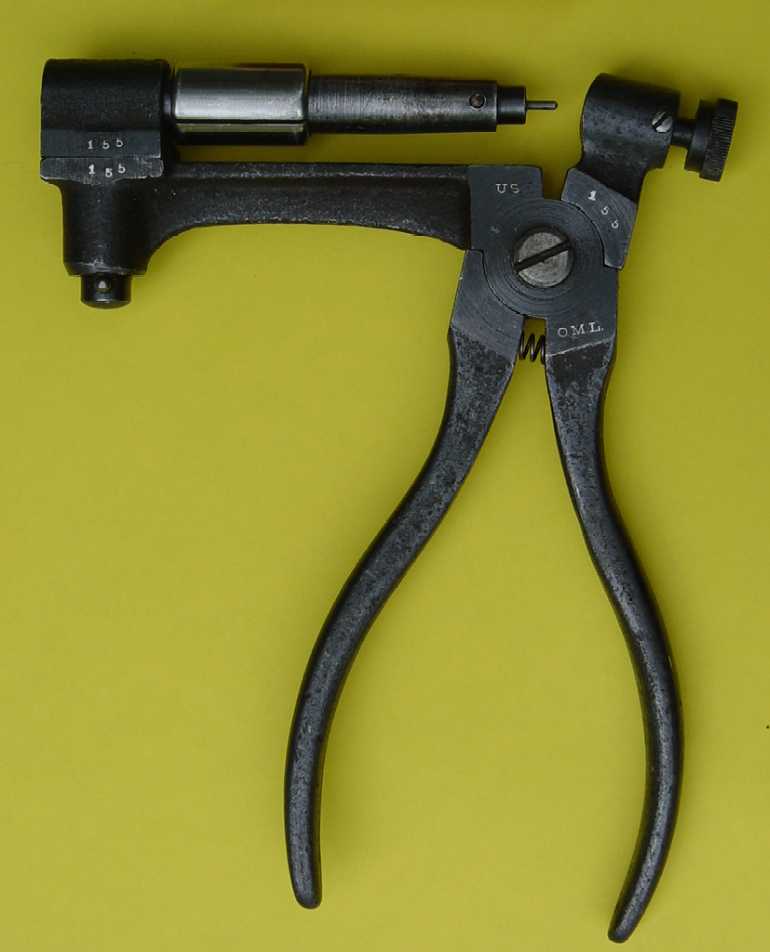
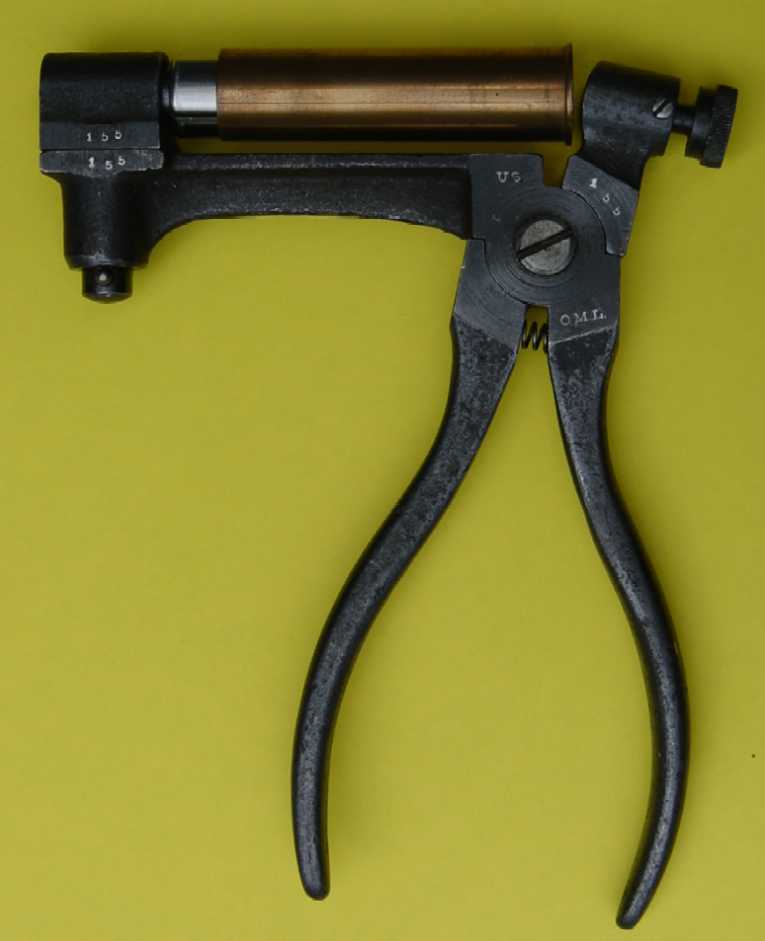
In the picture on the left, the sleeve is in place on the spindle, which
is installed on the tool with the de-priming pin positioned to remove the
primer. The setter screw (the knob-like part in the top right of the picture) has been backed out to
allow the old primer to be pushed out of the shell. In the picture on the
right, the shell is in place on the spindle, ready to be de-primed with a
squeeze of the handles of the tool.
.
.
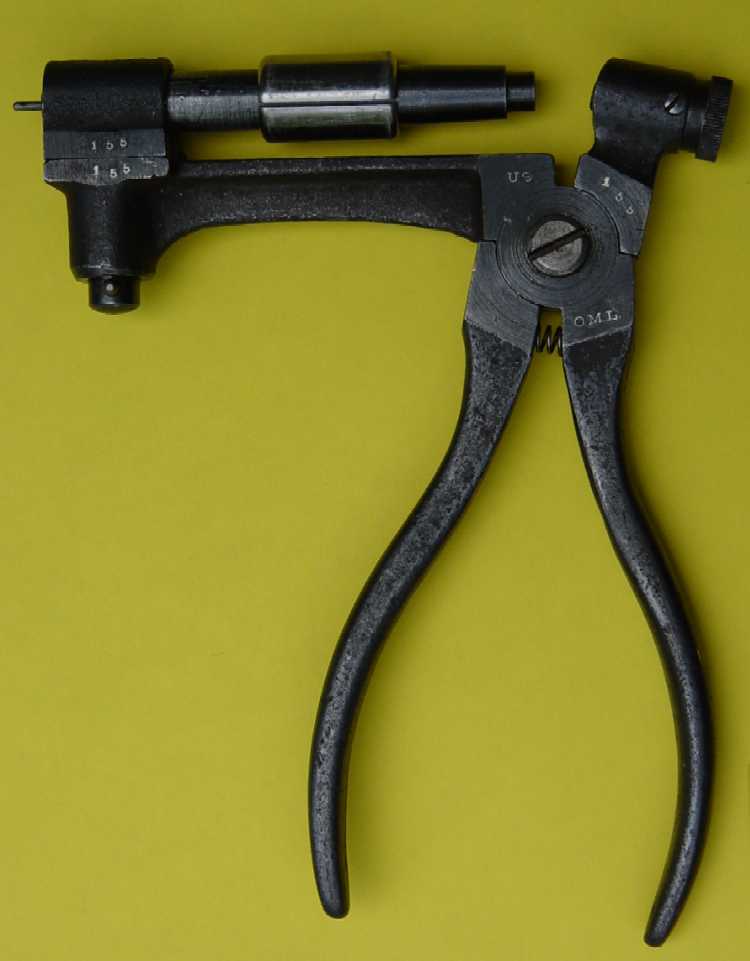 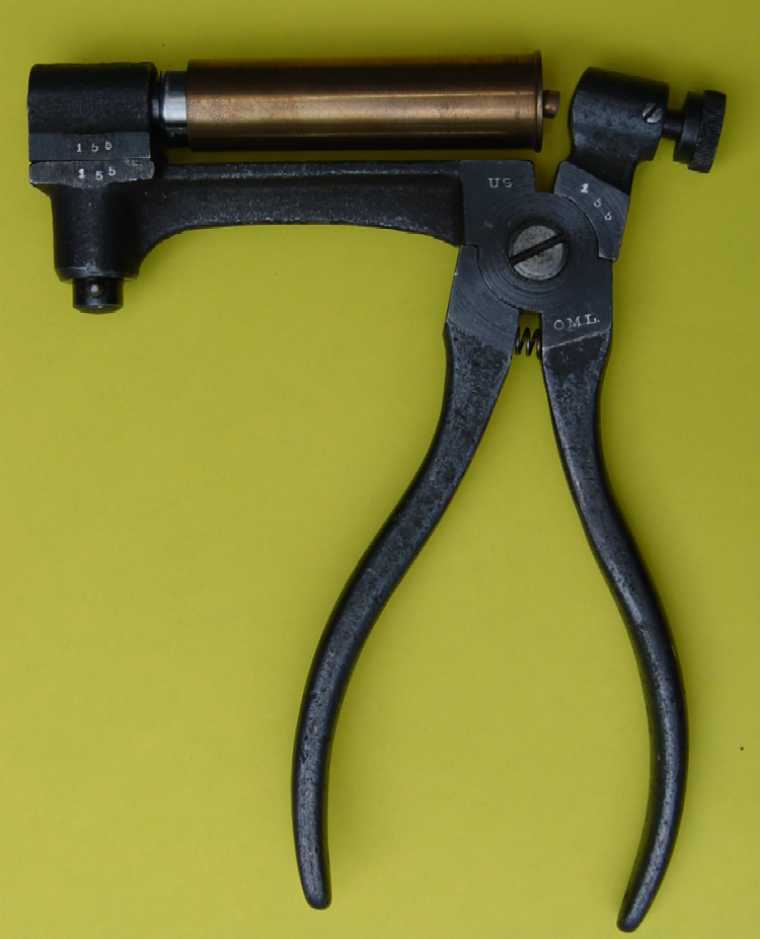
The left picture shows the de-primed shell, the primer still
partially in place in its pocket, but easily flipped out of the way
with a fingernail. On the right, the spindle is reversed for re-priming the
shell. The setter screw has been screwed all the way in so that its concave
end is in position to push the new primer in place in the shell.
.
.
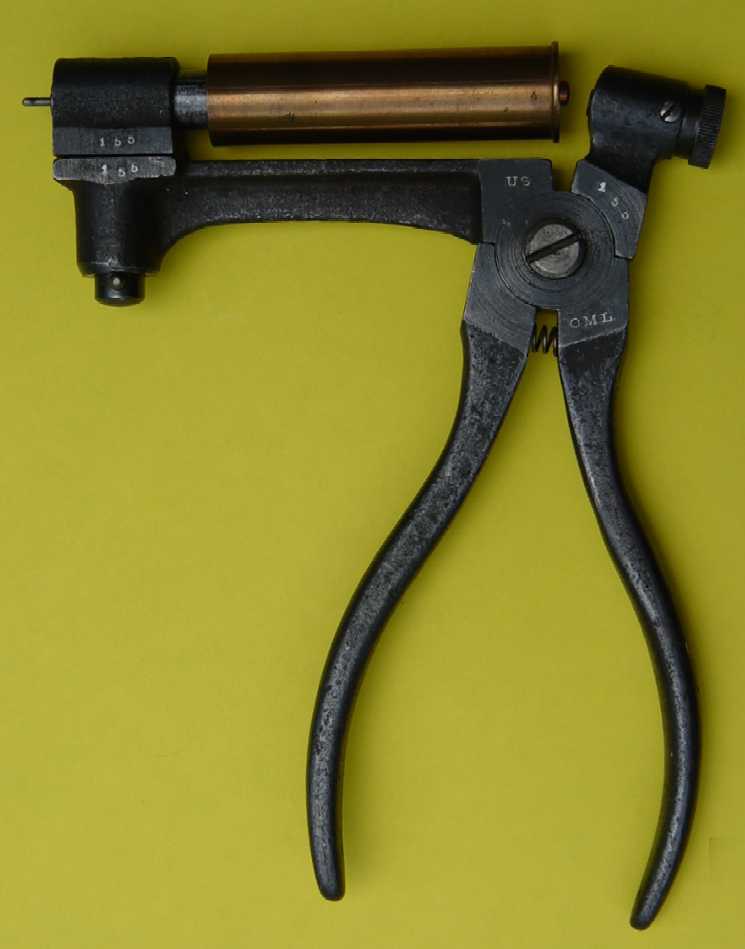
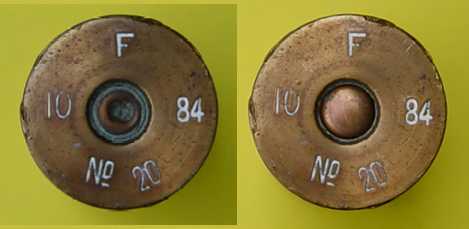
The picture on the left shows the shell in position on the spindle for
re-priming, and the primer has been partially pushed in place. The right
picture shows the head of the shell before and after the re-priming process.
The headstamp indicates that this shell was made at the Frankford Arsenal in
October of 1884.
.
.
Shown below is an illustration taken from the Reports of the Chief
of Ordnance for 1882, showing the components of the Frankford Arsenal shotshell
reloading set, and the May 16, 1882 patent drawing for the Gill priming
tool. The sleeve is shown in both.
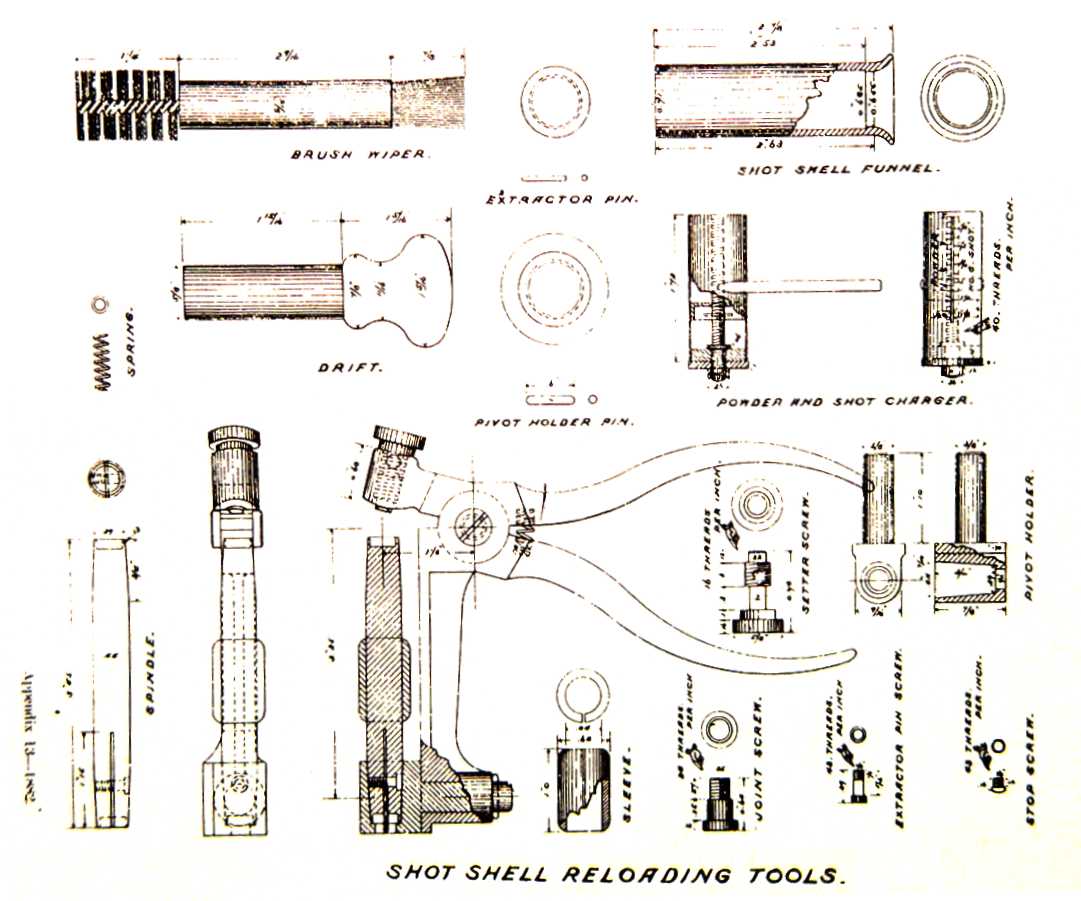
.
.
.
.
.
.
.
.
.
.
.
.
.
.
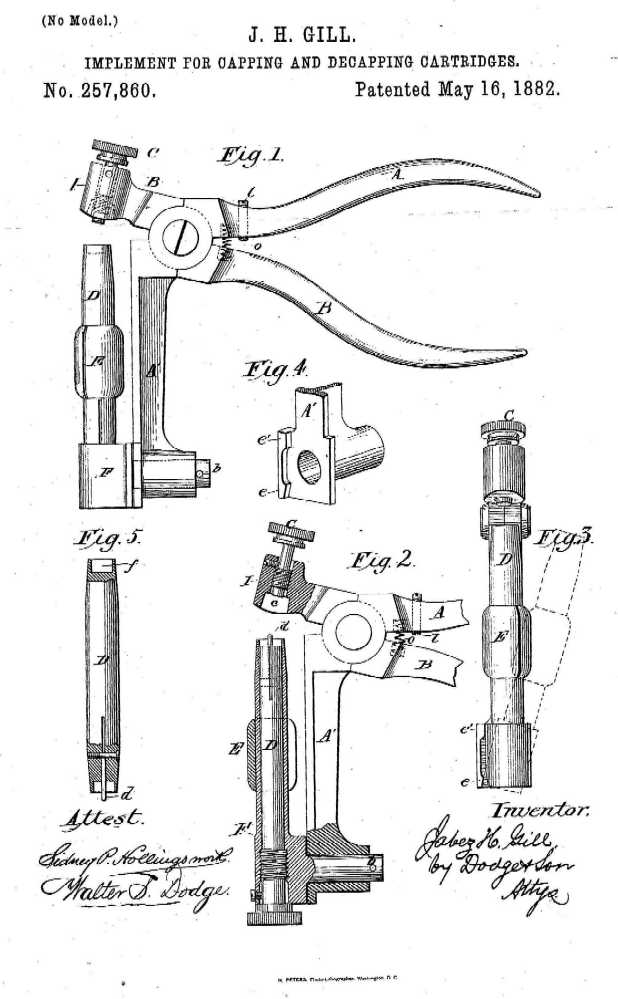
.
.
.
.
.
.
.
.
.
.
.
.
.
.
.
.
.
.
.
.
.
.
..
.
.
.
.
|

 Here's
an interesting item that will be of interest to the cartridge collector, as
well as the Springfield Trapdoor enthusiast, US history buffs in general,
and those who are looking for the $2 garage sale find that will virtually
guarantee you an appearance on the Antiques Road Show. In 1876, the US Centennial Exposition was
held in Philadelphia. One of the many exhibits at the exposition consisted
of a working display of cartridge-making machinery from the Frankford
Arsenal, which was used to demonstrate the processes involved in manufacturing ammunition. The
cartridge cases that were produced were given away as souvenirs to the visitors
at the exposition, but, surprisingly, few seem to have survived. These
souvenirs consisted of special inert Benet-primed copper .45-70 ball (2.1")
and blank (1.6") cartridge cases with a unique 1776 USC 1876
headstamp, as well as multi-piece draw sets, similar to the one pictured,
showing the various stages in the production of the cartridge case. As
originally produced, it has been suggested that these draw sets consisted of
16 pieces, as shown in this illustration taken from Robert Buttweiler's
Here's
an interesting item that will be of interest to the cartridge collector, as
well as the Springfield Trapdoor enthusiast, US history buffs in general,
and those who are looking for the $2 garage sale find that will virtually
guarantee you an appearance on the Antiques Road Show. In 1876, the US Centennial Exposition was
held in Philadelphia. One of the many exhibits at the exposition consisted
of a working display of cartridge-making machinery from the Frankford
Arsenal, which was used to demonstrate the processes involved in manufacturing ammunition. The
cartridge cases that were produced were given away as souvenirs to the visitors
at the exposition, but, surprisingly, few seem to have survived. These
souvenirs consisted of special inert Benet-primed copper .45-70 ball (2.1")
and blank (1.6") cartridge cases with a unique 1776 USC 1876
headstamp, as well as multi-piece draw sets, similar to the one pictured,
showing the various stages in the production of the cartridge case. As
originally produced, it has been suggested that these draw sets consisted of
16 pieces, as shown in this illustration taken from Robert Buttweiler's

 Looking
like just one more of the many variations of the French thick-rim cartridge,
this is actually a 11mm Bachmann-primed example, recognizable by its
characteristic irregular-edged flat 'disc' primer and its blunt nose lead
man-stopper-style bullet. The thick-rim family of cartridges was intended for use in Lefeauchaux
and other pin-fire revolvers that had been converted to centerfire. In the process of the conversion, the straight
chambers of the cylinders of these revolvers were cut to accept the rims of the centerfire
cartridges; the purpose of the extra-thick rim was to completely cover and
seal the holes around the perimeter of the cylinder intended for the
pins of the original pinfire cartridges to pass through..
Looking
like just one more of the many variations of the French thick-rim cartridge,
this is actually a 11mm Bachmann-primed example, recognizable by its
characteristic irregular-edged flat 'disc' primer and its blunt nose lead
man-stopper-style bullet. The thick-rim family of cartridges was intended for use in Lefeauchaux
and other pin-fire revolvers that had been converted to centerfire. In the process of the conversion, the straight
chambers of the cylinders of these revolvers were cut to accept the rims of the centerfire
cartridges; the purpose of the extra-thick rim was to completely cover and
seal the holes around the perimeter of the cylinder intended for the
pins of the original pinfire cartridges to pass through..  The
Gill priming tool that is included in the set of Frankford Arsenal reloading
tools shown on my picture page last month, in addition to being used for
de-priming and re-priming the .45 Colt, .45-55, 45-70, and .45-80
cartridges, was also used with the 20 gauge shell that was produced for the Springfield Model 1881 shotgun. Converting the tool for this purpose
requires a sleeve (the silver, slotted piece in the top left of this
picture) to be slipped onto the spindle to hold the shell in place. This
priming tool is marked 'U.S.' and 'O.M.L.', the initials of ordnance
inspector Major Ormond Mitchell Lissak; in addition, the three major parts
of tool are marked with assembly number 155. The sleeve has no markings, and
could easily be overlooked as a Frankford Arsenal accoutrement. The
following pictures demonstrate the priming process.
The
Gill priming tool that is included in the set of Frankford Arsenal reloading
tools shown on my picture page last month, in addition to being used for
de-priming and re-priming the .45 Colt, .45-55, 45-70, and .45-80
cartridges, was also used with the 20 gauge shell that was produced for the Springfield Model 1881 shotgun. Converting the tool for this purpose
requires a sleeve (the silver, slotted piece in the top left of this
picture) to be slipped onto the spindle to hold the shell in place. This
priming tool is marked 'U.S.' and 'O.M.L.', the initials of ordnance
inspector Major Ormond Mitchell Lissak; in addition, the three major parts
of tool are marked with assembly number 155. The sleeve has no markings, and
could easily be overlooked as a Frankford Arsenal accoutrement. The
following pictures demonstrate the priming process.






